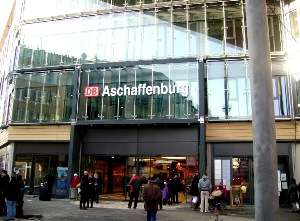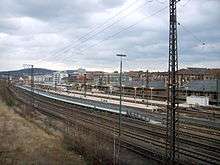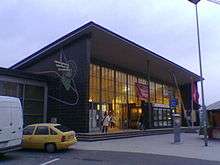Aschaffenburg Hauptbahnhof
Aschaffenburg Hauptbahnhof is the main station of Aschaffenburg in the German state of Bavaria/ It is located on the busy Ruhr– Frankfurt–Nuremberg–Munich/Vienna rail corridor. Deutsche Bahn classifies it as a category 2 station.[2] It forms the boundary between the city centre and the district of Damm.
| Bf | ||||||||||||||||||||||||||||||||||||||||||||||||||||||||
 | ||||||||||||||||||||||||||||||||||||||||||||||||||||||||
| Location | Aschaffenburg, Bavaria Germany | |||||||||||||||||||||||||||||||||||||||||||||||||||||||
| Coordinates | 49°58′49″N 9°08′37″E | |||||||||||||||||||||||||||||||||||||||||||||||||||||||
| Owned by | DB Netz | |||||||||||||||||||||||||||||||||||||||||||||||||||||||
| Operated by | DB Station&Service | |||||||||||||||||||||||||||||||||||||||||||||||||||||||
| Line(s) | ||||||||||||||||||||||||||||||||||||||||||||||||||||||||
| Platforms | 3 island platforms 1 side platform | |||||||||||||||||||||||||||||||||||||||||||||||||||||||
| Tracks | 8 | |||||||||||||||||||||||||||||||||||||||||||||||||||||||
| Train operators | DB Fernverkehr DB Regio | |||||||||||||||||||||||||||||||||||||||||||||||||||||||
| Other information | ||||||||||||||||||||||||||||||||||||||||||||||||||||||||
| Station code | 187 | |||||||||||||||||||||||||||||||||||||||||||||||||||||||
| DS100 code | NAH[1] | |||||||||||||||||||||||||||||||||||||||||||||||||||||||
| IBNR | 8000010 | |||||||||||||||||||||||||||||||||||||||||||||||||||||||
| Category | 2[2] | |||||||||||||||||||||||||||||||||||||||||||||||||||||||
| Website | www.bahnhof.de | |||||||||||||||||||||||||||||||||||||||||||||||||||||||
| History | ||||||||||||||||||||||||||||||||||||||||||||||||||||||||
| Opened | 1854 | |||||||||||||||||||||||||||||||||||||||||||||||||||||||
| Services | ||||||||||||||||||||||||||||||||||||||||||||||||||||||||
| ||||||||||||||||||||||||||||||||||||||||||||||||||||||||
| Location | ||||||||||||||||||||||||||||||||||||||||||||||||||||||||
 Aschaffenburg Location in Bavaria  Aschaffenburg Location in Germany  Aschaffenburg Location in Europe | ||||||||||||||||||||||||||||||||||||||||||||||||||||||||
History


The passenger station was originally located at the modern marshalling yard, which has been mostly dismantled. The station was opened in 1854 with the commissioning of the Bavarian Ludwig Western Railway (Ludwigs-West-Bahn]) on what was then a green field. During the Second World War, the station as a hub represented a target for allied air raids, including on the night of 1/2 April 1942.[3] The original station building was destroyed in an air raid on the railway facilities on 29 December 1944.[4] In the first half of the 1950s, a new building by Hans Kern was built on the same site in an objective style. The entrance hall had a large glass front, a flat roof and an extension with the station restaurant.

The station was renewed starting in 2004 with the raising of the platforms and the installation of lifts. This involved the demolition of the old station building and the building of a new building with a large commercial space and a parking garage with over 400 parking spaces. The new building was opened on 29 January 2011.[5] An extension of the new platform underpass to the north to the district of Damm was opened at the end of February 2012 to improve access to the station for the residents of that district. Another parking garage was opened in April 2012 with about 200 commuter parking spaces on two of the six parking levels. The traffic flow on the station forecourt on the southside of the station, which is on the northside of central Aschaffenburg, was redesigned.
In October 2010, a miniature copy of the Hermes-Mosaik (Hermes mosaic), which was previously mounted on the outside wall, was attached to the east side of the new entrance building. The old work of art was reproduced as a digital photo print on four aluminum panels. The majority of the original tiles were rescued without permission of the station's owner just before the demolition of the station building and reassembled by the graphic artist.[6]
Infrastructure
The passenger station has seven through platform tracks and a bay platform at the eastern end of the station. The six tracks adjoining to the north (tracks 101 to 106) are primarily used for freight. The tracks of Aschaffenburg Hbf were controlled until 1974 by many decentralised mechanical and electromechanical signal boxes. Since 1974, they have been controlled by a push-button relay interlocking signal box at the eastern end of the station.
Transport services
The station is served from different directions. The ICE line 41 connects the station every hour with Munich and the Ruhr area. During the daytime there are still some IC and ICE connections to Hamburg, Nuremberg and Vienna. There is a RE and a RB service to Frankfurt, together running approximately every half hour. The RB 58 service runs from Frankfurt south via Aschaffenburg to Laufach. An RB service runs to Miltenberg at least every hour, which is complemented by a RE service to Crailsheim every two hours. The RB 75 service (Rhine-Main Railway runs to Wiesbaden hourly; there are additional services in the peak. The RE 54 or 55 runs hourly to Würzburg.
| Train class | Route | Services |
|---|---|---|
| ICE 41 | (Dortmund –) Essen – Köln Messe/Deutz – Frankfurt (Main) – Aschaffenburg – Würzburg – Nuremberg – Munich | Every 60 minutes |
| ICE 91 | Frankfurt – Hanau – Aschaffenburg – Würzburg – Nuremberg – Regensburg – Plattling – Passau – Wels – Linz – St. Pölten – Vienna | individual services |
| IC 31 | (Passau –) Nuremberg – Aschaffenburg – Frankfurt (Main) – Mainz – Koblenz – Bonn – Cologne – Hagen – Dortmund – Hamburg (– Kiel) | individual services |
| RE 54/RE 55 | Frankfurt (Main) – Hanau – Kahl (Main) – Aschaffenburg – Lohr – Gemünden (Main) – Würzburg (– Bamberg) | Every 60 minutes (every 120 minutes to Bamberg) |
| RE | Aschaffenburg – Miltenberg – Wertheim – Bad Mergentheim – Crailsheim | every 120 minutes |
| RB 75 | Aschaffenburg – Babenhausen (Hess) – Dieburg – Darmstadt – Groß-Gerau – Mainz – Wiesbaden | Every 60 minutes
(Every 30 minutes in the peak) |
| RB 58 | Laufach – Aschaffenburg – Kahl (Main) – Hanau – Maintal – Frankfurt (Main) Süd | Every 60 minutes
(in the peak between Frankfurt Süd and Aschaffenburg) |
| RB | Aschaffenburg – Miltenberg – Wertheim | individual services (Main Valley Railway) |
| RB | Aschaffenburg – Miltenberg – (Amorbach – Walldürn – Seckach) | Every 60 minutes Mon - Fri
Every 120 minutes Sat-Sun |
| RB 58 | Aschaffenburg – Laufach – Heigenbrücken – Lohr – Gemünden (Main) | Every 60 minutes in the peak |
From 1891 until the end of the 1950s, the so-called Mainländebahn (Main lands railway) branched off below the Bischberg (hill) to the former rafting and trading port. Between 1911 and 1974 there was also a passenger train connection via the Aschaffenburg−Höchst (Odenwald) railway) to Höchst im Odenwald. Since the road link in the Bachgau is congested, especially in the peak hour, a reactivation of this connection, at least to Großostheim, is regularly discussed.
The regional bus station is in front of the station. This provides links in all directions, including to Alzenau, Schöllkrippen, Mainaschaff, Kahl and Obernburg. Many of these buses run every hour or every half hour. Within the city many of these bus services follow the same route so that on some routes buses run about every 2 minutes.
References
Footnotes
- Eisenbahnatlas Deutschland (German railway atlas) (2009/2010 ed.). Schweers + Wall. 2009. ISBN 978-3-89494-139-0.
- "Stationspreisliste 2020" [Station price list 2020] (PDF) (in German). DB Station&Service. 4 November 2019. Retrieved 15 November 2019.
- Stahl 2015, p. 39.
- Stahl 2015, p. 268.
- "Prominenz feiert neuen Hauptbahnhof". Main-Echo (in German). 27 January 2011. Archived from the original on 31 January 2011. Retrieved 10 May 2018.
- "Der Schutzherr der Reisenden fliegt wieder". Frankfurter Allgemeine Zeitung (in German). 27 October 2010. p. 48.
Sources
Stahl, Hans-Günter (2015). Der Luftkrieg über dem Raum Hanau 1939–1945 (in German). Hanau.